Jacquard technique is closely related to knitting, as the basic principles of turning rows and draw-throughs are often used. Crocheting techniques are also gaining popularity as the process is faster
Thanks to simple patterns with descriptions, you can create mixed patterns, use techniques in different variations and more. For beginners, the basic principles of knitting, accessible patterns, secrets of techniques are revealed, and master classes on creating various items of clothing and interior are given.
Features of crochet jacquard
The patterns created using the jacquard technique were originally presented on a loom. By means of a complex interweaving of threads on a loom, interesting patterns appeared.

The technique of the same name was loved by the masters, as a result of which jacquard fabric appeared. The production principle did not change, but due to the lack of power in the production machines, the masters began to weave patterns on the canvases by hand.
Jacquard crochet for beginners (diagrams and patterns with descriptions are presented below) often remained a complex and confusing process. Many confused the fabric with tapestry due to the repeating shades of the characteristic relief. The design and color palette are constantly changing.
Jacquard is also valued for its high durability and noble textures. Several mixed types of threads and their colors can be used in the work - by thickness, composition and textural features.
Usually, for the jacquard technique, it is customary to use more than 2 shades of yarn to create unusual patterns:
- animal colors in corresponding motifs;
- Scandinavian ornaments - Norwegian Christmas deer, snowflakes, Christmas trees;
- traditional patterns of different cultures;
- geometric shapes for women's and men's patterns;
- floral prints.
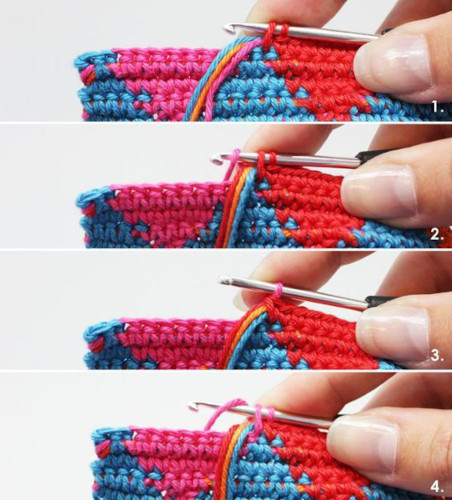
Jacquard can also be used to practice making simple patterns. There are single-color and two-color combinations, patterns, and also patterns using several shades of yarn. The basic principle is to use several colors in one row. In some patterns, the number reaches 3-4 shades.
Depending on the knitting principle, the interlacing of threads occurs according to the rules of stocking knitting using the traditional pattern of alternating loops.
If you need to knit multi-colored patterns, the diagram includes a detailed description for the crochet technique:
- according to the diagram, the cell is equivalent to one VP;
- how many cells in one row - that's the number of loops you need to cast on;
- cell color - shade of threads;
- odd rows are determined by knit stitches;
- even rows - purl stitches;
- circular rows consist of only knit stitches;
- The pattern according to the diagram should be knitted from the bottom up.
Yarn for crochet jacquard is selected taking into account the thickness of the threads. It is advisable to take colors of the same size (thickness), so that the finished sketch is not dense and uniform.
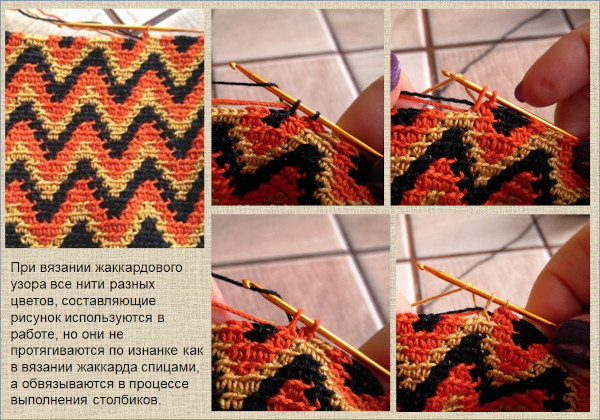
The softer the yarn, the easier it is to knit multi-layer rows with loops with yarns. As a rule, linen or cotton yarn is most often used. It is not advisable to take viscose or too slippery threads, as they do not hold the shape of the loops well.
Preference should be given to wool and acrylic - an ideal option for simple and complex patterns. Before knitting, the yarn should be washed and dried to check whether it sheds. Only after checking can you start knitting the ornament to create a sketch.
Jacquard crochet with turning rows
The most convenient way to knit is circular jacquard, as the thread can be twisted with your fingers. Loose loops can be easily picked up with a free hook or spare knitting needle. In the process of live knitting, twisted threads are not noticeable in the pattern.
If the back side is difficult, the craftsmen resort to cutting the fabric. Also, for a safe process, you can buy a special thimble for jacquard. It protects the skin of the fingers from excessive rubbing.
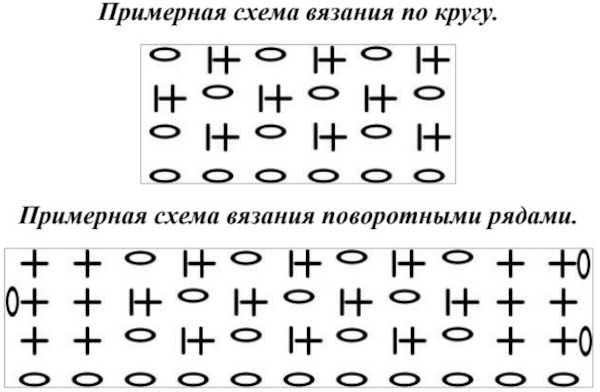
It is worth remembering about colored yarn: a thread of a different color can be threaded in the next row, except for the first one. In this case, it needs to be pulled up so that there are no sagging, and the loops are the same size.
When twisting the thread, it is better to skip 2-3 loops, otherwise, if you skip 1/1 of the loops, the fabric may seem too dense. Because of this, the threads of a different color will stick out from the front side.
Jacquard crochet for beginners (the patterns for this master class are described below) can be done in a pattern for a cover. The work requires Alize Sekerim Bebe yarn made of 100% acrylic. Yarn consumption is 320 m / 100 g.
It is recommended to take shades of almond and beige (255 and 498). You will also need 200 m/50 g of Pekhorka yarn made of 100% acrylic in the color coffee with milk (186). You will need to select buttons for the fastener, eye fasteners, the eyes themselves, and a #3 hook separately.
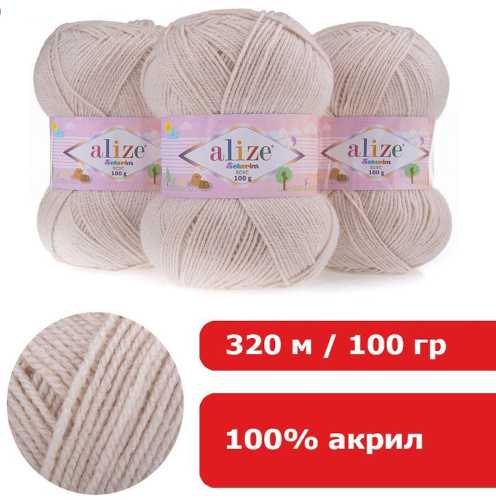
- From the diagram you can create a cover measuring 10*17 cm.
- To change the size of the sides, you need to reduce or increase the number of loops in the chain stitch of the main row.
- To adjust the height, you need to change the number of rows that the chain is tied with.
For ease of reading, the diagram is provided with the following symbols:
| KA | amigurumi ring |
| SBN | single crochet |
| Arr. | increase (2a sbn in one VP) |
| Killed. | decrease |
| VP | air loop |
| SS | connecting post |
| 1.2.3. | row numbering |

First, the cover needs to be knitted in a light color:
- First, you need to make a chain of 22 VP (1 of them for lifting).
- Next, you need to knit the first row of sc in a circle.
- On each side you need to knit 22 VP with SC without increases or decreases.
- All 44 sc need to be tied into a chain.
- The next 11 sc on the front side need to be knitted together, and then connected into a ponytail. To do this, you need to knit 7 VP (where 1 is for lifting, 6 SS in the opposite direction), and then continue knitting in a circle.
- Then you need to knit 11 sc in a circle along the tail side and additionally knit 22 sc along the back side.
- Then you need to knit the spots with a different color of yarn. To do this, you need to prepare the thread for knitting in advance.
- When the yarn of the working color is finished on the hook, you need to knit the last column with a new color. It is not the working thread that should be placed inside the loops, but the length - along the entire row.
- The height should be 5 rows for each spot according to the pattern. The greatest height is 5 rows from the beginning of the next spot relative to the previous one. You can rely on an arbitrary shape of the pattern. All spots should be knitted on both sides.
- Next, you need to close 27-28 rows to work with the yarn of the second color. The spots should be connected, and the ends of the threads should be tucked inside the loops along the row.
- For the valve, take a light-colored yarn and knit 22 sc in turning rows (1 ch for lifting at the end of each row).
- In total you need to knit 11 rows.
- The beige shade of yarn does not need to be laid any further. In the middle of the row, the thread should be left along it without breaking.
- After knitting the valve, you need to knit a beige CC around the perimeter from the center. So you should reach the middle of the valve, and then knit 8 VP to fold the fabric. Next, knit the clasp, and then you need to knit it and close the row.
- The loose thread should be cut, hiding the end inside the loops.
Next, you need to knit the head, ears and nose separately.

To do this, you first need to tie the head:
- You need to dial 6 SC in the KA, then make approx. 6 times.
- After approx. *6, you should have 18 sc knitted in a row.
- Next, knit 1 sc and make 1 inc.
- After 1 inc * 6, you need to knit 2 sc.
- After 24 sc, you need to knit 6 more inc, and then secure the thread in the 24th VP.
- Then you need to knit SS, 1 VP and cut the thread.
For ears:
- You need to make a chain of 4 VP, where 1 VP is the lifting one.
- Next, from 2-1 VP from the hook, tie the binding in the opposite direction from the thread.
- Next you need to tie an inc, 1 sc and make an inc (repeat 2 times) to get 16 sc.
- Next you need to knit 1 sc, inc, 3 sc, 1 inc and repeat the process until you reach 20 sc.
- Then you should knit 22 sc and make a dec.
- Then you need to knit 8 sc and repeat the pattern twice until you get 20 sc.
The thread should be cut, securing it in the last loop.
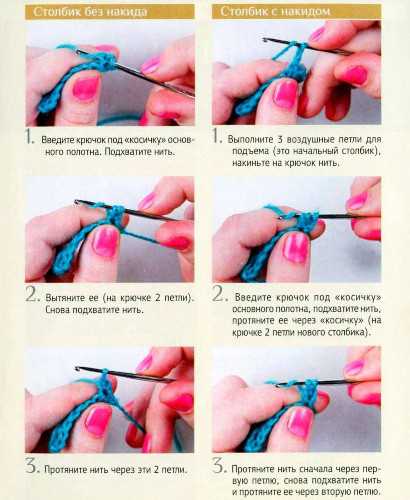
The horns should be knitted according to the pattern:
- First, you need to dial 5 sc in the KA.
- Then you need to knit 5 sc 3 times.
- The thread needs to be passed through the last row and the edge trimmed.
All the parts then need to be assembled and connected to each other.
In a circle
Jacquard can also be knitted in a circle, as with knitting needles. In the crochet technique, two different colors can be used, which is convenient for beginners due to the ease and variety of options.
Most often, such patterns are found for knitting bags and covers. The most attractive is the bag in the Colombian style "mochilla", which is made from a pipe. The main aspect of such an accessory is the bottom with patterns and walls.
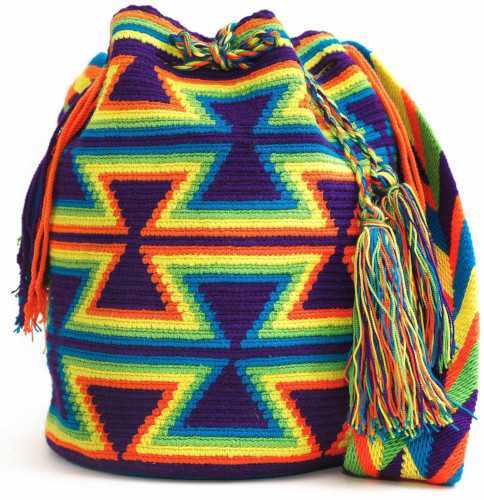
This jacquard is knitted without draw-throughs only from the back side. The thread remains inside each single crochet, and the loop passes through the back wall of the previous row.
To crochet any item in a circle, you need to follow the basic rules:
- single crochet stitches only;
- loops are knitted behind the back wall;
- 1 VP is always output for lifting;
- at the end of the rows there is always 1 CC;
- The change of colors in the pattern occurs at the end of the previous row.
To knit a product, it is important to correctly calculate the pattern diagram. Almost every detail is knitted the same way; only the rows and the length of the air chain differ in the number of loops (in length and height).
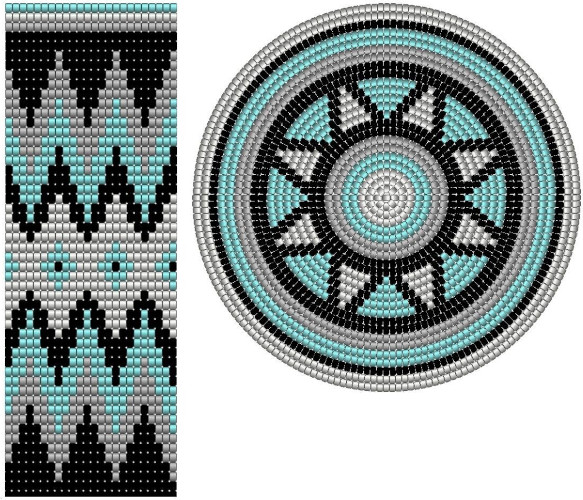
The pattern rapport must be calculated separately:
- First, you need to choose a pattern and calculate its rapport on checkered paper.
- The number of loops to create a chain can be counted relative to the cells.
- If the pattern is 8 stitches, then you need to cast on a total number of stitches that is a multiple of 8.
- To change the thread, you need to cut off a part and place it at the beginning of the next row so that the tail remains inside the loops.
- The main thread of the pattern never changes. It is inserted inside as the color pattern is knitted.
- Before changing the thread, you need to close the color of the current yarn. Then, according to the pattern, you should knit 2 sc with the new color.
- If you need to return to the main thread, its first column should be closed with a colored thread behind the back wall of the loop.
- According to the diagram, you need to repeat all the steps to change the threads.
- To get a smooth edge, you need to pull the remaining threads through the loops inside.
- The loops can be pulled up with the last thread so that they are level with the others.
Just like with the turning rows, the pattern in the circle can be knitted from thick, dense yarn. The main thing is to choose the hook and the characteristics of the colored threads.
In a circle without displacement
The principle of knitting without displacement is to tie a working fixed thread, which is located inside the future loops. For work you will need 100% wool in the volume of 100 m / 250 g and hook No. 3.5.
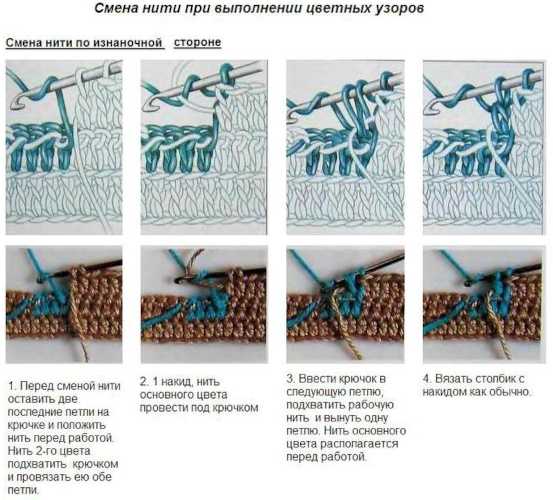
- You need to dial 4 VP and connect them into a ring.
- Then you should tie them with 7 sc.
- In each loop you need to knit 2 sc and get 14 working loops.
- Next, knit 2 CCH, and in the 2nd VP knit 1 SC.
- Next, you should knit 2 loops of the base color into a loop of a different shade, knit 2 new loops, and in the next row knit 2 loops of the base color, so that you can then knit 3 new loops from them.
- This pattern needs to be repeated until the rapport has 6 alternating loops with different shades.
- Then you need to knit according to the pattern described above, but insert the hook with loops of the base color into the middle between the loops of a different color.
- In the next row, you need to knit 2 new loops from 1 loop of the base color. Continue this way until you get a complete pattern.
- By the 14th row, you can see a pattern with a counter-clockwise shift.
Such color patterns resemble a cyclical spiral pattern, although the spiral technique is different. Further, an interesting ornament can be obtained by continuing the rapport upwards.
Without broaches
The draw-through in crochet technique is a pattern in which the base thread remains inside the product after knitting 2-3 rows. The fabric on the back side contains the main color of the thread, and the loops - another.

To knit with a different color, the previous color must be left inside the rapport. Such disguises of threads are called draw-throughs. They are acceptable if the pattern involves frequent changes of yarn colors.
But if the thread needs to be pulled through 6 or more loops, it is customary to break the thread, as it can catch and hang down.
The reverse side with such large stretches looks unaesthetic. Therefore, in such cases, the threads are crossed before knitting a new loop. For example, you can create a rapport from simple patterns.
| kr. | edge |
| persons. | face loop |
| out. | purl stitch |
| G. | knit with color #2 |
| and. | knit with color #3 |
| f. | knit with color #4 |
| m. | knit with color #5 |
To complete the rapport, you need to knit the fabric without a pattern up to the 50th row.
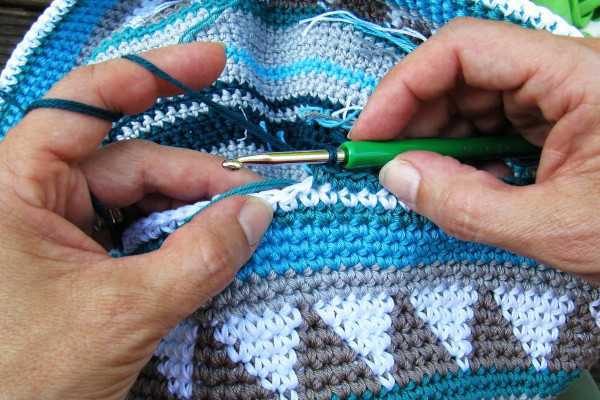
Next:
- In the 51st row you need to knit the pattern *3 front p., g., 1 front p. f.* 30 times, cr.
- In the 52nd row you need to make a pattern *1 out. p., g., 1 out. p. f.* 60 times, cr.
- In the 53rd row, knit the pattern *1 front p., g., 1 front p. f.* 60 times, kr.
- In the 54th row you need to knit the pattern *1 purl p., g., 3 purl p. f.* 30 times, cr.
- In the 55th row you need to cast on the pattern *1 front p., f., 1 front p. f., 3 front p. f.* 30 times, 1 front p., f., 2 front p., f., cr.
- For the 56th row you need to knit *1 purl. p., g., 1 p. p.f.* 61 times, cr.
- In the 57th row, do the pattern *3 purl p., f., 1 k. p. f.* 31 times, k.
- In the 58th row you should knit all purl stitches and purl stitches.
All the ends of the threads must be woven into the loops, raising them to the top.
With broaches
Jacquard crochet for beginners (the patterns are no different from crochet patterns without broaches) will seem simple if you take as a basis the knitting pattern of a small pattern with broaches.
They are not so “dangerous” for small patterns, do not spoil the overall appearance of the product and do not cling to the hook. First, you need to dial 30 VP and knit 1 row of SC.

- Next, you need to knit 1 VP for lifting, 3 SC in color #1, 1 VP in the same color.
- When there are 2 VPs left on the hook, you need to lower the yarn of color No. 1 behind the fabric, grabbing the yarn of color No. 2 with the hook. It should be pulled through both loops.
- Having put new yarn on the hook, you can knit another 4 VP, then move on to even 5 front sts.
- On the 6th loop you need to change the thread, as in the first case. To do this, you should knit 2 VP and remove the thread behind the fabric.
- Turn the product over and knit 1 row of knit stitches from the wrong side.
- When you need to remove a thread in a purl row, it should be left in front of the fabric.
All the stitches remain inside the pattern. This is acceptable if the rapport pattern is not designed for very wide and high patterns.
In bricks crochet technique
Bricks crochet is a crochet technique that allows you to create double-sided fabric with multi-colored patterns on both sides. You can knit patterns in both rotary and circular rows.
At first glance, the pattern resembles a house made of bricks that are arranged in a checkerboard pattern. At the same time, multi-colored threads do not need to be laid along the rows, since the knitting is obtained without broaches.
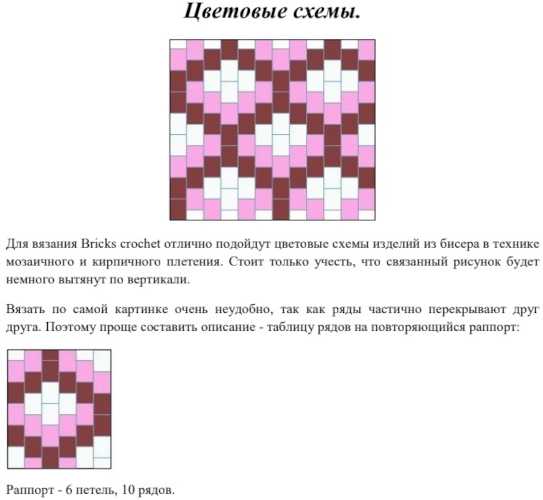
It is also noteworthy that knitting can be done on a square, circle or even a cylindrical shape. For work, you can take yarn of any thickness that you like. This parameter does not matter here. The patterns for bead weaving can be used as a basis for the scheme. They turn out graceful and ambiguous when crocheting.
The work will contain descriptions containing the following abbreviations:
| VP | air loop |
| SHSBN | wide single crochet - the hook needs to be inserted into the top of the arch of one of the VP. Then the loop should be pulled out, yarn over and pulled through 1 VP on the hook. Next, the hook needs to be inserted into the same arch, but then the loop should be pulled out, pulling it through. Then yarn over again and pull through all 3 VP on the hook. |
| SBN | single crochet |
| NSBN | initial single crochet - VP and SC should be crocheted together into the first loop of the row. This pattern has an advantage for crocheting in the round. |
Sometimes SC can be replaced with SC to make the knitting less dense and voluminous. For knitting, you can take any shades of yarn that will look good in a mosaic pattern.
For a better understanding of the pattern, rapports and tables are often made from diagrams, since the pattern is difficult to read from the diagram. Rows overlap each other, blocking the ability to read the next step.
A repeat pattern rapport might look like this: 6 VP for 10 rows.
For each row, you need to indicate the number of SCVN that should be knitted in one color or another:
| Description | |||
| Row | White | Pink | Violet |
| 1 | 1-W | 1-V | |
| 2 | 1-W | 2-V | |
| 3 | 1-P | 1-V | |
| 4 | 2-P | 1-V | |
| 5 | 1-W | 1-P | |
| 6 | 2-W | 1-V | |
| 7 | 1-W | 1-V|1-V | |
| 8 | 1-P | 2-V | |
| 9 | 1-P|1-P | 1-V | |
If the chart contains repetitions in the form “1-P|1-P”, this means that the pattern should be knitted in the forward and reverse direction. For example, for row #7, first knit 1-V, then 1-W, and then 1-V again.

Operating principle:
- First, you need to dial the number of VP that corresponds to the pattern in the diagram.
- Then you should make an increase of 2 edge sts on each side.
- The edge loops should be knitted with regular sc.
- In the first row you need to knit SC, in the 2nd - SC.
- In the 3rd row you need to knit a single crochet, and in the 4th row you need to knit between each pair of single crochets, continuing to knit according to the pattern on the side where there is a VP.
- All colors of yarn must be introduced into the fabric at the very beginning of knitting, even if some shade is used from the 6th row.
- The SCBS should be knitted into arches, capturing threads of other shades to completely hide them in the pattern.
- To finish knitting, you can make all the sc, or knit 2 sc in each arch.
It is important to monitor the tension of the yarn here. When the thread is changed between wide SC, you need to knit a new color VP so that the next SC has a new color in the loop.
With fillet ornament
Jacquard crochet for beginners (patterns for filet crochet are presented in the form of drawings) with an ornament may seem complicated, but this is the simplest pattern that is found in this crochet technique. Drawings in one strip and contrasting with a smooth color transition are distinguished.
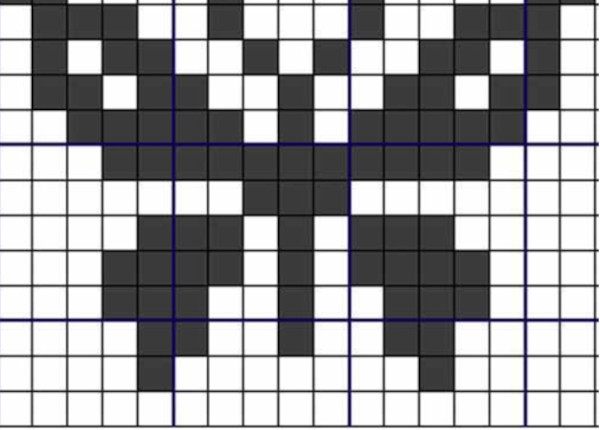
The whole pattern can be knitted for the front wall of the fabric using the SC method in a circle. Mercerized cotton yarn with a volume of 350 m/100 g is suitable. For work, you will need a hook No. 2.5.
Lazy Jacquard Crochet
A very popular trend in crochet technique due to the ease of reading the patterns and the availability of a large number of designs. However, it is quite difficult to come up with a pattern in this technique on your own.
They are very easy to knit: every 2 rows you need to knit with one yarn, and then remove the pulled loops from the previous row in a certain order. Due to the interweaving of yarn of different colors, an interesting pattern is obtained.
When knitting a regular 2-color pattern, you need to knit each row with 2 carriage passes. For lazy jacquard, one row will be enough. All loops must be repeated, since each of them implies a loop of a new color. Accordingly, they must be knitted twice in a strict periodic order.
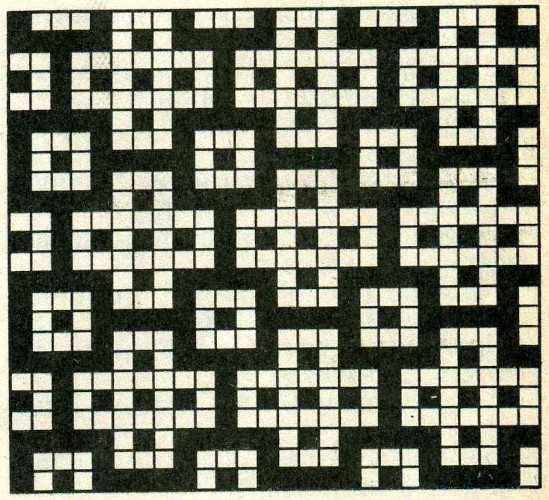
To knit a similar pattern, you need:
- wool yarn with acrylic 50/50%;
- hook No. 4;
- yarn of other colors of the same thickness.
By pattern:
- The stitches knitted on the front side in an odd row should be knitted in the same color in even rows, but with purl stitches.
- The loops removed in the 1st row must be removed in the following rows without knitting.
- The working thread should be on top of the unknitted loops.
- If in an even row the loops are knitted as front loops, then in an odd row you need to knit all the loops as wholes using the purl method.
- Each odd row should be knitted with a new color of thread.
To make it easier to work, you can make a designation scheme for each color of yarn in odd rows - 1C, 1B, etc.
Choice of colors
Since jacquard uses different knitting techniques, it is important to understand how and when the threads of different shades will be introduced into the pattern.
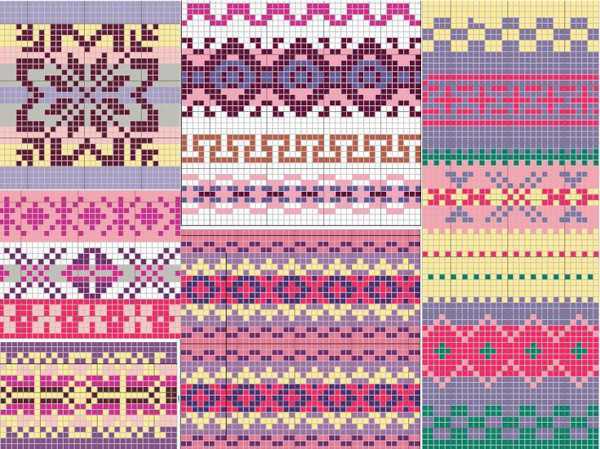
Based on this, you can choose:
- yarn of not bright colors, which will not be noticeable in hidden loops;
- bright two-color gradient yarn if you need to create a pattern with one thread;
- yarn of several colors to create a colorful pattern;
- shades of values of one color - to create a faded contrast between the pattern and the canvas.
Advice: The shade value does not play the most important role, since for wide stripes the pattern may remain unnoticeable against the background of a bright contrasting color.
To highlight the pattern, it is best to choose dark or light colors. The surface area of a particular color may be larger, so for such patterns it is better to combine opposite shades.
Jacquard in crochet technique can be done in various color schemes. Beginners should prepare tables with symbols and drawings separately from the descriptions for the schemes.
This will make it clear exactly how and in what direction to knit the patterns. Thanks to the wide variety of loop weaving variations, you can create beautiful designs for clothing, accessories and hats.
Video about crochet jacquard
Jacquard crochet without thread breakage:
